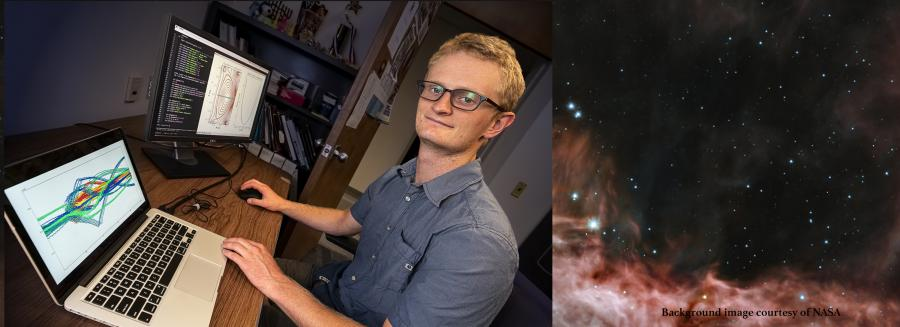Mar 11 2020
At the DIII-D National Fusion Facility, which is operated by General Atomics for the U.S. Department of Energy (DOE), scientists have discovered that fusion performance improves when pellets of hydrogen ice are injected instead of puffing hydrogen gas.
 Physicist Oak Nelson. Image Credit: Photo and composite by Elle Starkman.
Physicist Oak Nelson. Image Credit: Photo and composite by Elle Starkman.
The two methods were compared by physicists from DOE’s Princeton Plasma Physics Laboratory (PPPL) and Oak Ridge National Laboratory (ORNL) whose work looks ahead to the fuel that will be used in ITER, the international fusion experiment under construction in France.
Improve the Temperature
The team demonstrated that the use of icy hydrogen pellets enhances the fusion plasma temperature when compared with the gas fueling method often used in doughnut-shaped fusion facilities known as tokamaks. Higher temperatures are advantageous for fusion reactions. The outcomes on DIII-D are promising for ITER, which intends to employ the pellet injection method to fuel its hot inner core.
Fusion is the power that drives the sun and stars, combines lighter elements in the form of plasma—the state of matter comprising negatively charged electrons and positively charged atomic nuclei—to generate enormous amounts of energy. Researchers across the world have attempted to reproduce fusion on Earth to power a clean, safe, and almost inexhaustible supply of power to produce electricity.
One main difficulty in the production of fusion energy is figuring out how to find ways to get cold hydrogen fuel into the hot plasma core. In contrast to the sun, which consists of enough hydrogen required for billions of years of fusion, fusion reactors on Earth must feed hydrogen constantly into the plasma to preserve the fusion reactions. In current experiments, hydrogen is commonly injected by puffing room-temperature gas.
Bigger and Hotter
However, when the size and temperature of the fusion reactors increase, it will be challenging for the gas to enter into the reactor core where fusion reactions occur. Therefore, there is a need to develop new methods to feed the fusion core without affecting plasma performance.
As part of the collaborative research effort on DIII-D, the two fueling methods were compared in high-performance plasmas planned for ITER. The experiments showed a considerably higher plasma pressure—which is essential for fusion reactions—when hydrogen ice was used compared to gas injection in which the fueling rate is almost evenly matched between the two methods.
The fueling plays a big role in the edge plasma performance.
Andrew “Oak” Nelson, Graduate Student, Program in Plasma Physics, Princeton University
Nelson is the first author of the Nuclear Fusion article that reports these results. He is also part of a multi-institutional team that meticulously designed and performed the experiments.
Scientists at ORNL
Researchers at ORNL designed the technology for injecting the ice pellets. Advanced scientific instruments formulated by various collaborating institutions on DIII-D are essential to interpret the experimental results.
It’s great to see how our multi-institutional effort came together to tackle this important fueling question for ITER and future reactors.
Morgan Shafer, Study Co-Author and Lead Research Scientist, ORNL
The study also shows how graduate students can crucially contribute to the field of fusion energy by working on these large national research facilities.
For a graduate student to play an important role in this experimental study on DIII-D is impressive. Oak’s success shows how large fusion experiments provide significant leadership opportunities for students and early career scientists.
Egemen Kolemen, Physicist, PPPL and Princeton University
Kolemen was an advisor for the project. This study was supported by the DOE Office of Science.